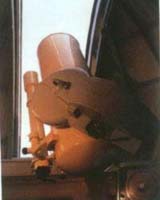Throughout our history, humanity has built technology to enable faster, cheaper or larger transportation from one point to another. Although many of these feats faced great difficulties from the drawing board to the final product, our world has been blessed by these inventors efforts decades later as the airplane, train and automobile can testify.
But before any of these inventions were fully developed, skeptics and doubters have mocked either the possibility of an invention or the need for one. Since the Space Elevator definately falls into this category, here are ten reasons why a space elevator should not be built to benefit humanity.
_____________________________________10)
Too complex to succeed: The technology behind a space elevator has too many moving parts. It lacks the simplicity of a rocket engine.
9)
It's too expensive: It would be better to spend $10 billion on developing new ways to kill each other on dozens of projects than to pool our money into this single one.
8)
It's a dumb idea: The space elevator has only existed in science fiction novels. Since when has anything from a science fiction novel become reality?
7)
It will take too long: If such a feat can not be built in my generation, why should the next one have the honor to benefit from it?
6)
It's too hard: We should focus on solving easier topics such as ending war and global poverty.
5)
It would ruin Star Trek: The writers never envisioned a space elevator in their television series. Building one would ruin the story line, enraging fans across the scifi community.
4)
We need Space Powers: If too many nations have access to space, people might get the notion that we are all created equal, leading to chaos.
3)
Rockets are doing a fine job: Despite 95% of their weight being fuel, rockets are doing a great job hauling up cargo and people. Who needs change?
2)
Space is for the elite: Only the healthy and wealthy deserve to visit the stars. The poor and unhealthy deserve their lot on Earth.
1)
The English language has too many words: We have too many "ports" on planet earth already, such as seaport, airport, carport, etc. Adding
LiftPort to the dictionary would only increase the cost of dictionaries worldwide.
_____________________________________Note: These are the best reasons I could come up with. Does anyone else have a better excuse?
























![ColonyWorlds[at]Gmail[dot]com](http://img.photobucket.com/albums/v438/hiddennook/ColonyWorlds.png)






